skip to main |
skip to sidebar
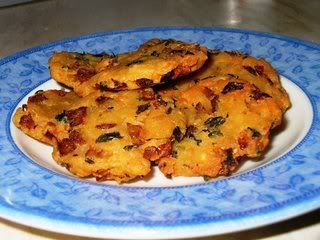
Yep, they look nice, dont they? :) They WERE nice. Ever since I saw the recipe for maddur vada on Latha's blog a few weeks ago, by sheer chance (I'd googled "maddur vada"), I'd been hankering to make them. They're simple to make, and really best eaten fresh while they're still fairly crisp. I personally liked their chewy texture a day on, but I think that could just be me, a one-woman fan club.
I used the same ingredients as specified in Latha's recipe, but made a small addition of my own - urad dal that had been soaked for 2-3 hours. I think I had a vague of idea of the really really scrummy "Tirupati vada" that I'd eaten long ago, before the Tirupati laddoo became the only prasadam (holy offering) available. The Tirupati vada was dark brown, very chewy, and had urad dal in it. I havent a clue about the rest of the ingredients in that prasadam - all i remembered was the texture and the fact that there was urad dal in it.
The urad dal DID make a difference to the maddur vada - if only in taste. I'm quite glad I made the addition!
Recipe for: Maddur vada
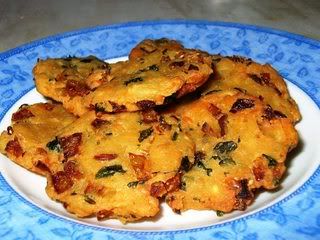
Ingredients:
1 cup fine semolina
1/2 cup rice flour
1/4 cup plain flour
1 tsp red chilli powder
5 tbsp hot oil for kneading
2 onions, finely chopped
1/2 cup urad dal, soaked for 2-3 hours
1/2 cup coriander leaves, chopped
10-15 fresh curry leaves, chopped
Fresh green chillies to taste, minced
Salt to taste
Oil for deep frying
Method:
1. Heat the oil in a deep pan.
2. Put the rice flour, plain flour, semolina, red chilli powder and salt in a bowl. Add 5 tbsp hot oil and and mix well with a wooden spoon.
2. Add the chopped onions, urad dal, coriander, curry leaves and chillies.

Mix with enough water to make a rough dough. Use your hand for this.
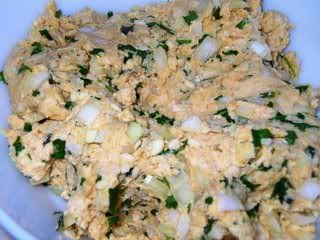
3. Take a small ball of this dough and flatten with your fingers (or use a glass, greasing its bottom well) on a non-stick sheet.
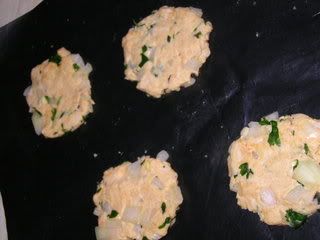
4. Drop into hot oil and deep fry on medium-high heat until golden brown.
5. Serve hot with any dipping sauce.
I was inspired to make suji halwa when I saw Atabela's recipe for it. It seemed like such a good idea and a nice change from the usual suji halwa. A small bag of unsweetened dried berries was begging to be used, so the decision was made.
I also added some traditional sultanas and cashewnuts to the halwa, although I guess most nuts (maybe not peanuts, though) would taste just as good. Oh, and the only calories in it come from the ghee, because I used Splenda instead of sugar. There's just no way to compromise on the ghee, unfortunately, because of the flavour and aroma it imparts.
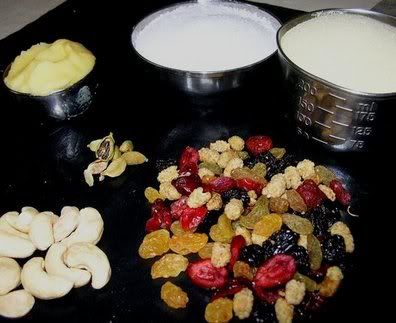
Clockwise from bottom right: Mixed dried berries (cranberries, strawberries, sour cherries and sultanas), cashewnuts, cardamom, ghee, Splenda and suji.
Suji halwa is a quick, fuss-free sweet to make - it's also homey and sort of soothing. Or maybe that's because I associate it with memories of home.
This halwa is nicest eaten hot (the microwave comes in handy here, if you're not eating it fresh). I didnt make mine the usual formless mass of halwa - I spread it on a lightly greased plate straight from the cooking pan, and cut it into squares. The berries looked like little jewels studding the little squares of halwa. They looked pretty and were the perfect size to satisfy my undemanding sweet tooth, one square at a time. And did I say they looked pretty?
Recipe for: Suji halwa with dried berries
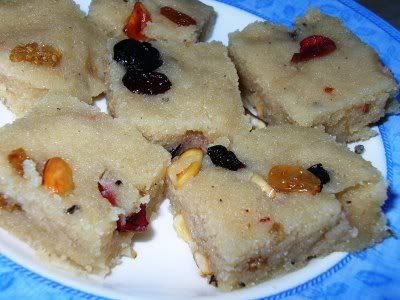
Ingredients:
1 cup suji
3/4 cup sugar or Splenda
1/4 cup ghee
3/4 tsp cardamom powder
1/3 cup mixed dried berries and sultanas
2 cups water
Method:
1. Heat 1 tsp of the ghee in a small pan and fry the berries and nuts until the nuts turn golden. Remove from the hot pan (to stop them browning further) and reserve.
2. Melt the remaining ghee in a wide pan.

3. Add the suji to the ghee and roast it on medium-high heat, stirring frequently, until the suji starts to turn a darker colour (about 10 minutes) and gives off a nice roasting aroma.
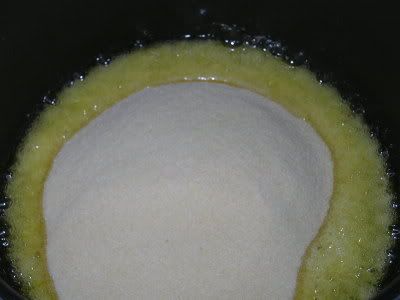
4. The suji is done when it becomes wet-looking and the ghee begins to separate from the mixture.
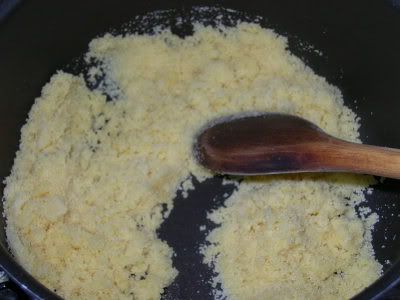
5. Now is the time to add the berries and nuts, and the sugar. Stir it all into the roasted suji mix.

6. Add the cardamom powder and two cups water to the pan and stir well and frequently, making sure there are no lumps.
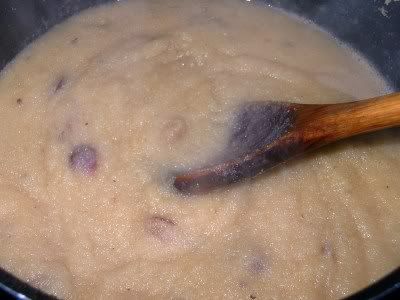
7. Keep stirring until the suji absorbs the water and the mixture pulls away from the sides of the pan. At this point, stirring will be difficult as the halwa will have become a soft mass. Turn off the heat. The halwa can be served rightaway in cups.
8. If you want to make serving pieces like I did, spread the hot halwa on a lightly greased flat plate, patting it down quickly and carefully with a wetted palm. Cut into pieces when it has cooled a little.
The halwa stays good for 2 days, and can be re-heated in the microwave prior to serving.
When you have a craving for dosas but no regular dosa batter with which to indulge that craving, there's a quick way of getting your fix. Granted they wont taste like "proper" dosas, but pancakes can be made with any flour and still taste pretty good.
Yesterday I opted to make rava dosas (with the addition of a little rice flour and some wheat flour). The seasoning (or tempering) for the dosas is absolutely essential, because the batter is bland and unfermented.
The rava dosas you get in hotels in India are usually wonderfully crisp and thin, an effect very likely achieved with generous slatherings of ghee or oil. But since I wasnt about to drown my dosas in oil, they turned out mostly soft, but crisp in places - absolutely yummy with coconut chutney and sambar.
Oh, by the way - you can add finely chopped onions or other quick-cooking vegetables to the batter to make the dosas more nutritious.
Recipe for: Rava dosas (cream of wheat/farina/semolina pancakes)
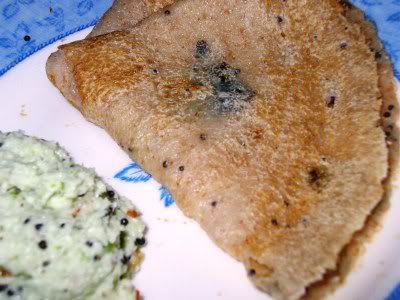
2 cups rava
1/2 cup rice flour
1/2 cup wheat flour (or all-purpose flour)
Salt to taste
Water as required
For tempering:
2 tsp mustard seeds
1 tsp cumin seeds
8-10 curry leaves
3-4 fresh green chillies, finely minced (according to taste)
2 tsp oil
1/4 tsp asafoetida powder (optional)
Method:
1. Use only as much water as required to make a pouring batter from the flours and salt. Set aside.
2. Heat the oil in a small pan and add the ingredients for tempering. Cover the pan and let the mustard seeds pop.
3. Pour the tempering on the batter and stir well.
4. To make the dosas, heat a non-stick tava and spread a couple of ladlefuls of batter in a swirling motion, trying to keep the dosa as thin as possible.

5. Cook on medium heat till the top dries out and the bottom part is golden, then carefully lift with a spatula and turn it over.
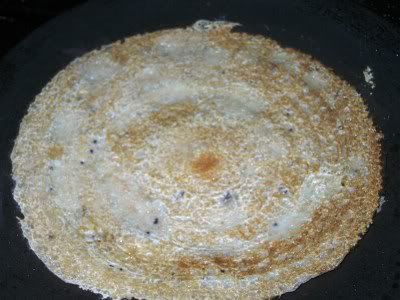
Let this side cook till the dosa becomes stiff. (It will soften as it cools.)
6. Serve hot with chutney and sambar.
















